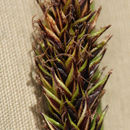Comments
provided by eFloras
Carex fissuricola is intermediate between C. luzulifolia and C. luzulina. A population in Lemhi County, Idaho, has the terminal spike gynecandrous and the perigynium glabrous or subglabrous. It is tentatively included in C. fissuricola.
- license
- cc-by-nc-sa-3.0
- copyright
- Missouri Botanical Garden, 4344 Shaw Boulevard, St. Louis, MO, 63110 USA
Description
provided by eFloras
Plants densely or loosely cespitose; rhizomes thick, short. Culms to 80 cm. Leaves: blades 3–8 mm wide. Inflorescences with 3–5 spikes; peduncles of proximal spikes exserted more than 1 cm; proximal bracts with blade (10–) 15–50 mm, sheaths cylindric to ± expanded to mouth, 20–37 mm, mouth with narrow, ± purple band at top, usually Y- or V-shaped, mouth 0.7–1.8 mm wide. Lateral spikes pistillate or often androgynous, purple to brown, proximal spikes pendent to erect, 14–25 × 4–7 mm. Terminal spike staminate or androgynous, ± erect, 10–21 × 4.5–6 mm. Pistillate scales purple or brown with pale, usually indistinctly veined, ovate to elliptic, 2.3–3.8 × 0.8–1.7 mm, midvein and margins ciliate, apex obtuse to short-awned. Staminate scales purple or reddish brown with pale midvein, ovate to obovate, 3–4.4 × 1–1.4 mm, margins slightly ciliate, apex obtuse. Anthers 1.5–3 mm. Perigynia ascending, usually purple or red-brown, veins usually indistinct, ovate to elliptic, 3.2–5.5 × 0.9–1.7(–2) mm, margins flat, less than 1/2 mature achene width, margins setose-ciliate distally, usually at least sparsely hispidulous to shortly setose; beak ± distinct, apex brown to purple, setose-ciliate, distance from beak tip to achene apex usually more than 2 mm. Achenes obovoid, body 1.5–2 × 0.8–1 mm.
- license
- cc-by-nc-sa-3.0
- copyright
- Missouri Botanical Garden, 4344 Shaw Boulevard, St. Louis, MO, 63110 USA
Distribution
provided by eFloras
Calif., Idaho, Mont., Nev., Utah.
- license
- cc-by-nc-sa-3.0
- copyright
- Missouri Botanical Garden, 4344 Shaw Boulevard, St. Louis, MO, 63110 USA
Habitat
provided by eFloras
Meadows, rocky stream banks; 1500–3500m.
- license
- cc-by-nc-sa-3.0
- copyright
- Missouri Botanical Garden, 4344 Shaw Boulevard, St. Louis, MO, 63110 USA
Synonym
provided by eFloras
Carex ablata L. H. Bailey var. luzuliformis L. H. Bailey
- license
- cc-by-nc-sa-3.0
- copyright
- Missouri Botanical Garden, 4344 Shaw Boulevard, St. Louis, MO, 63110 USA
Comprehensive Description
provided by North American Flora
Carex fissuricola Mackenzie, Muhlenbergia 5: 53. 1909
Carex luzulaefolia W. Boott, in S. Wats. Bot. Calif. 2: 250. 1880. (In part, not as to type.) Carex ablata var. luzuliformis L. H. Bailey, Bot. Gaz. 25: 272. 1898. (Type from Sierra Nevada
Mountains, California.) Carex luzulaefolia var. ablata f. luzulaefortnis Kukenth. in Engler, Pflanzenreich 4 20 : 558. 1909.
(Based on C. ablata var. luzuliformis L. H. Bailey.)
Densely cespitose, the rootstocks very short, the clumps medium-sized, the culms 5-8 dm. high, erect, much exceeding the leaves, phyllopodic, obtusely triangular, slightly roughened above, dark-brown and fibrillose at base, the dried-up leaves of the previous year conspicuous; sterile shoots little elongate, conspicuous; leaves with well-developed blades 6-10 to a fertile culm, the upper 2 or 3 very widely separated from one another, the rest clustered at base, the upper sheath 6-9 cm. long, the blades light-green, thickish but not leathery, flat, 7-25 cm. long, 3-8 mm. wide, very short-tapering, strongly striate, roughened at apex, the sheaths thin ventrally, truncate at mouth, the ligule very short; terminal spike staminate or often developing a few perigynia, sessile or short-peduncled, obclavate, 8-15 mm. long, 3-5 mm. wide, the scales oblong-oblanceolate, abruptly acute or mucronate from the projecting midvein, brownish-black with light-colored center and roughish, scarcely hyaline, subciliate margins; pistillate spikes 4 or 5, the upper 1-3 sessile or short-peduncled, and with the staminate spike closely aggregated, the others more or less strongly separated and shortto longexsert-peduncled, the peduncles rough, the spikes oblong, 8-30 mm. long, 6-9 mm. wide, rounded or somewhat attenuate at base, closely flowered, containing 15-40 spreading-ascending perigynia in several to many rows; bracts long-sheathing, the sheaths tubular, green, scarcely enlarged upward, the blades short or rudimentary, much shorter than the culms; scales narrowly ovate, acute, cuspidate, or short-awned, brownish-black with lighter hispidulous center, the margins narrowly hyaline, the midvein conspicuous to the tip, narrower and shorter than the perigynia; perigynia ovate, 4.5-5 mm. long, 1.75-2 mm. wide, much flattened, not inflated, very sparsely hairy at least when young, ciliate-serrulate on the margins above, membranaceous, puncticulate, greenand purplish-black-mottled, obscurely nerved, rounded at base, short-stipitate, abruptly contracted into a bidentate beak one fourth to one third the length of the whole; achenes obovoid, 1.75 mm. long, 1 mm. wide, about half the width of the perigynia, sharply triangular with concave sides, loosely enveloped, yellowish-brown, substipitate, apiculate, obscurely jointed with the straight slender style; stigmas 3, slender, lightreddish-brown; anthers 3 mm. long.
Type locality: Canon at the head of south fork of Humboldt River, Elk County, Nevada {Heller 2401).
Distribution: Mountain meadows, Wahsatch Mountains, Utah, western Nevada, and the Sierra Nevada of California from Tulare County north to El Dorado County. (Specimens examined from Utah, Nevada, California.)
- bibliographic citation
- Kenneth Kent Mackenzie. 1935. (POALES); CYPERACEAE; CARICEAE. North American flora. vol 18(6). New York Botanical Garden, New York, NY

